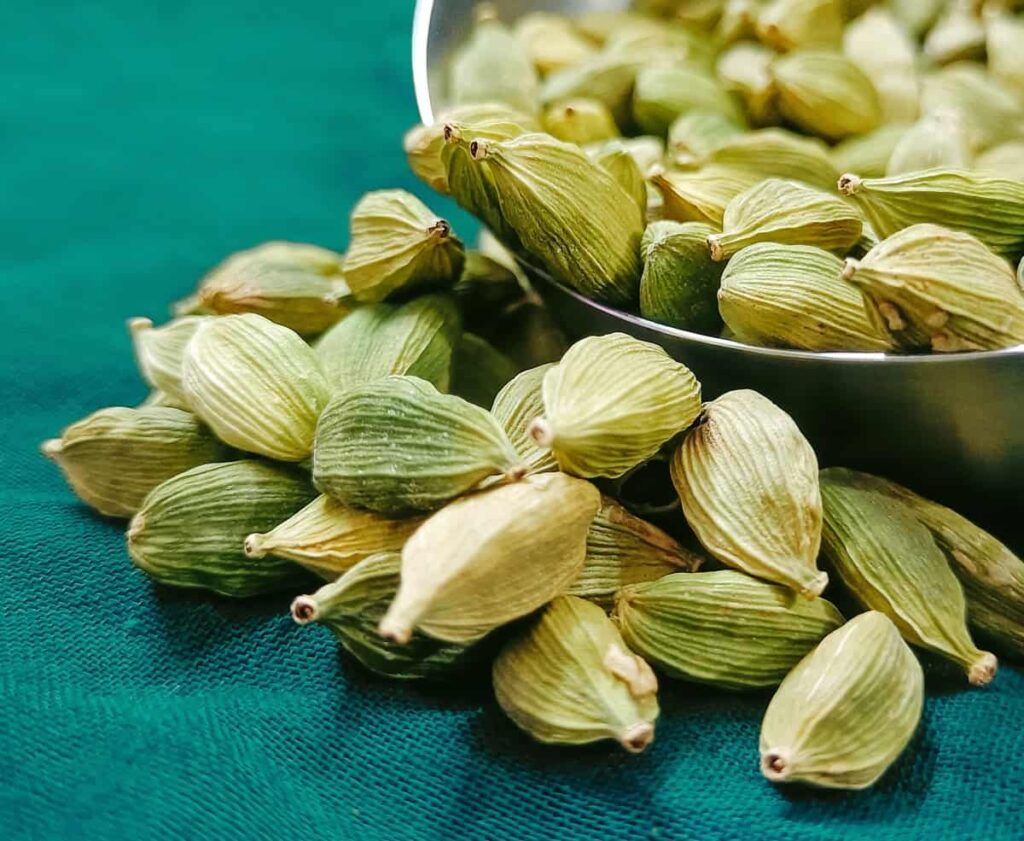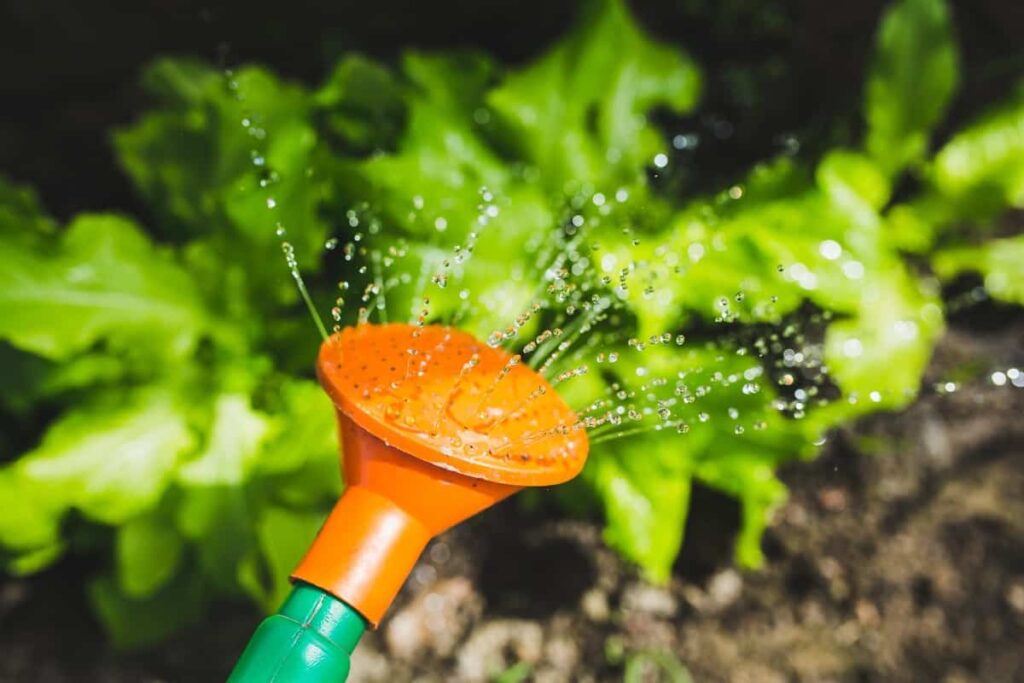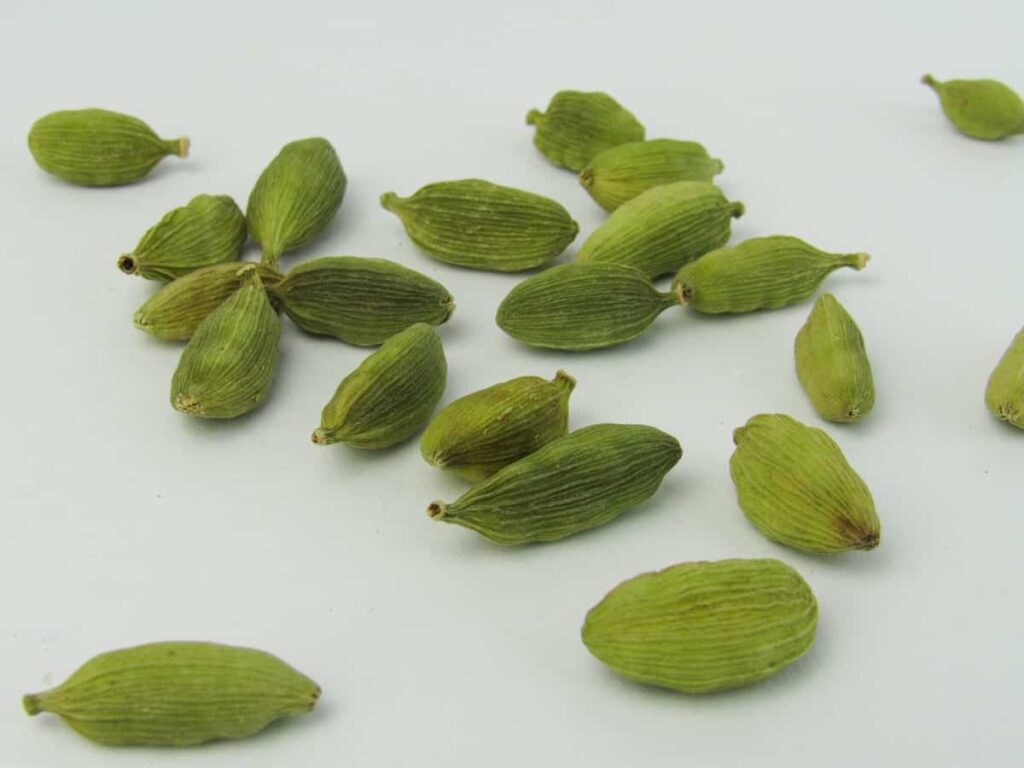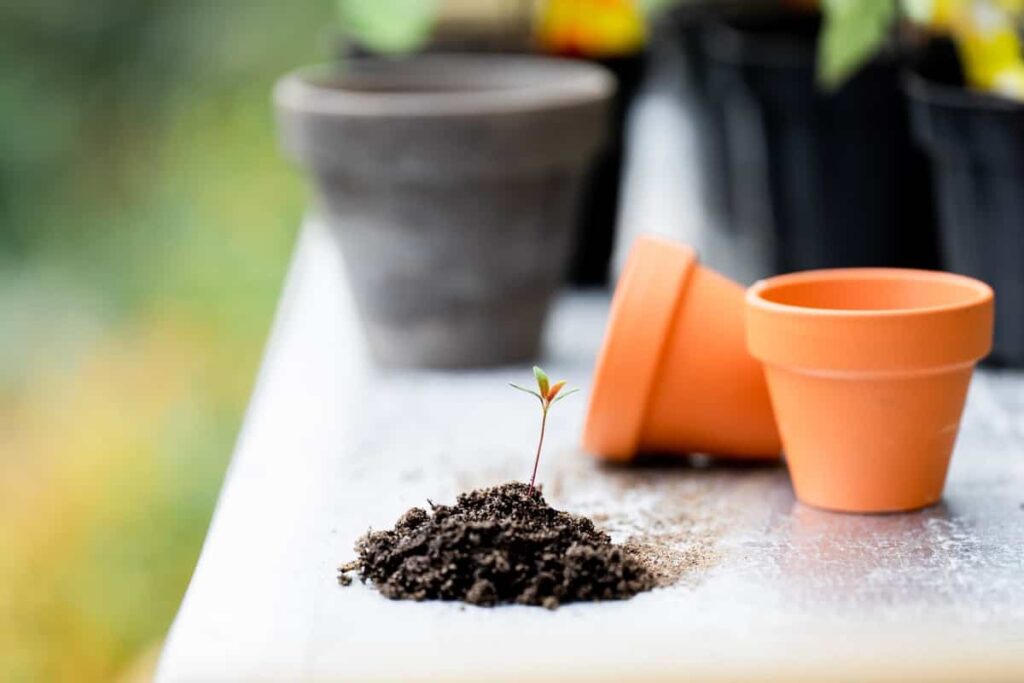Cardamom (Elettaria cardamomum) is one of the members of the ginger family. In addition to its intense aroma and glossy texture, Cardamom is an edible perennial herbaceous plant grown for its leaves. This plant’s genus name comes from Elettari, a vernacular name from Malabar, India. Let’s check out how to grow Cardamom in pots below.

Elettaria plants have erect stems with linear to lance-shaped leaves and are rhizomatous evergreens. The cardamom plant has thick knobby rhizomes, which produce upright shoots with long, narrow, dark green leaves. The cardamom tree can reach six to fifteen feet in height outdoors in tropical climates, growing on cane-like stems. Leafy shoots have linear-lanceolate leaves about 24 inches long, each shaped like a sword.
Flowering stems with lilac-purple veins and pink or yellow margins emerge from the plant base in late spring or summer. The flowers are white to yellowish-white, reminiscent of orchids. These pale yellowish-green fruit pods appear after the insignificant stems give way to small, aromatic, pale yellowish-green blooms. Seeds are aromatic black to reddish-brown and grow in oblong, thin-walled, smooth-skinned pods about 3/4 inch long. The seeds are highly aromatic, warm, and slightly spicy.
How to grow Cardamom in pots
Varieties of Cardamom
It is a home spice in two distinct forms: black and green Cardamom and a bleached version of green Cardamom known as white Cardamom. Recipes in India and Asia specify whether green or black Cardamom should be used, while Nordic and Middle Eastern cuisine often uses green Cardamom. As the name implies, green Cardamom is the true form of Cardamom. You’re most likely to find these in the supermarket’s spice aisle.
In case you missed it: Medicinal Plants/Herbs Contract Farming in India: Profits, Companies for Tulsi, Ashwagandha, Brahmi, Aloe Vera, Shatavari, and More

As well as being a great choice for sweet dishes, it is also an excellent choice for savory ones. White Cardamom contains less flavor than its bleached counterpart. Tropical areas, such as India, Malaysia, and Costa Rica, grow it. The pods of Black Cardamom are larger and dark brown. The smoky taste makes it suitable for savory dishes, but southern Indian sweet dishes can also use it. The eastern Himalayas are the region where it is grown.
How to propagate and grow Cardamom from seed in containers
- Instead of cracking open a couple of pods from the pantry, purchase seeds designed explicitly for planting.
- Place the seeds in a glass jar and cover them with a solution of 2.5 percent nitric acid.
- Pour the seeds and acid into a strainer after stirring for two minutes. Make sure the seeds are thoroughly rinsed.
- After placing the seeds in a bowl, cover them with warm water and allow them to soak overnight.
- If you are planting outdoors, plant seeds about 1 foot apart, 1 inch deep, in partially shady conditions. Humus soil that is rich and slightly acidic is best for them. Alternatively, you can plant cardamom seeds in pots and bring them indoors for the winter.
- Cover the surface with grass or straw mulch. It can take anywhere from 20 to 40 days for seeds to germinate.
- Once they reach a height of 25 to 30 cm and develop a couple of leaves, they are ready for transplantation. They should be planted 6-18 inches apart in small pots that are not too deep. Supporting seedlings with stakes and mulch is essential.
- It is essential to keep the beds moist; too much watering is not good. The Bordeaux mixture can be sprayed occasionally to prevent fungal growth.
- Their proper growth requires regular weeding, removal of old and dying leafy shoots, mulching, regulating shade, manuring, fertilizing, and irrigation.
Cardamoms may begin producing capsules three to five years after they are sown. Flowers begin to bloom in April-May and continue until July-August. In most areas, capsules just shy of full ripeness are harvested between October and November, usually every 30-40 days. It is necessary to dry harvested fruits by exposing them to sunlight, heating them, or flue-curing them.
In case you missed it: Dairy Contract Farming in India: Companies, Agreement, Profits, How it Works and the Pros and Cons

Capsules with uneven green colors are bleached with bleaching powder, sulfur dioxide, or hydrogen peroxide. In subsequent years, higher and sustained yields can be obtained, up to the tenth or fifteenth year, depending on the type of cultivation.
Cardamom plant care
In the Malabar region of southwest India, which receives about 150 inches of rain per year, Cardamom is commonly found growing in tropical monsoon forests of the Western Ghat Mountains. There have also been cultivations of Cardamom in tropical areas worldwide, which have naturalized in Tanzania, Vietnam, and Central America.
Alternatively, you can plant Cardamom in a rain garden where it will tolerate wet soil or in an edible garden combined with other shade-tolerant herbs, greens, and vegetables. Container gardening is also possible with this herbaceous perennial.
Sunlight requirements for growing Cardamom plant
As Cardamom is a tropical plant, it cannot tolerate temperatures below 15°C outside. Therefore, it is best to keep the plants in pots and place them outside at most in the summer, but then in partial to full shade. After the nighttime temperatures in autumn fall below the minimum temperature, Cardamom must be brought indoors and overwintered in a bright and warm environment.
Type of soil required to grow Cardamom plant
Potting compost should be fertile and based on loam. You can add leaf mold or granulated bark to the soil if you are planting in bright, unfiltered light with high humidity. Under glass, Cardamom can thrive exceptionally well since it requires tropical conditions to produce its best fruit. An ideal soil type is sandy, loamy, rich in organic matter, and rich in manure. An acidic to neutral pH of around 6 to 6.8 is required for it.
As well as acidic soils, they tolerate soils between 5.5 and 6.0 pH. It is essential to grow Cardamom on a suitable substrate that is well-drained so that water drains out easily, but the soil must always remain moist. It does not mean that the soil is damp or soggy. Using clay soil is also not recommended because it kills the plants.
How and when to water your Cardamom plant
It is necessary to keep the soil moist at all times to grow the Cardamom plant. The soil cannot tolerate drought, so do not let it dry. During the summer, watering should be increased. In the summer, it is recommended to water the Cardamom plant twice daily. It is also essential to mist the leaves during the summer, as they grow under humid conditions.
A couple of times a day is sufficient for spraying water on leaves in the summer. Cardamom plants will turn brown if their leaf tips are low in humidity or if they are underwatered. The humidity should be increased by increasing the water and spraying the foliage. Avoid root rot by not overwatering. Overwatering or clogged water will cause the plant to wilt.
In case you missed it: How to Grow Poplar Tree: A Guide to Propagation, Planting, and Care

How and when to fertilize your Cardamom plant
It is possible to fertilize Cardamom organically and inorganically. During the growing season, use a potash-rich fertilizer (N:P:K = 1:1:2; potassium twice as much as nitrogen and phosphorus). If you want your roots to grow stronger, mix fish and bone powder in your plant soil. It is also recommended to apply neem cake.
Temperature and humidity required for growing a Cardamom plant
Plant Cardamom, where daily temperatures rarely dip below 22°C, as flowers and fruits will only grow there. Temperatures below ten °C will have the most significant impact on plant growth. You can grow Cardamom indoors in a heated greenhouse or a hot, steamy bathroom if you live in a semi-tropical or temperate climate.
Even though flowers and fruit are rarely grown indoors, Cardamom makes a lovely houseplant. Pebbles that are consistently moist should be set on a dish for the plant. Houseplants grow much smaller than outdoor plants, reaching 2 to 4 feet in height.
Common pests and diseases in the Cardamom plant
Diseases in Cardamom
| Disease | Cause and symptoms | Control methods |
Capsule Rot | Cause: Fungus Phytophthora spp Symptoms: Water-soaked lesions appear first, followed by rotting and shredding of leaves along the veins. The infected capsules become dull, greenish-brown, and decay. It emits a foul smell and subsequently sheds. | 1. Three sprays with Bordeaux (a combination of copper sulfate, lime, and water mixture) of 1% in May, June, and July. 2. Soil drench with Bordeaux mixture 1 % (or) Copper oxychloride 0.25% |
Clump or Rhizome rot | Cause: Fungus Pythium vexans Symptoms: Affected tillers can be pulled out with little force, and the clump’s basal portion can be discolored. Early symptoms on leaves appear as a pale yellow color, partial leaf margins, and withering. Rotting or decay starts at the collar region and spreads to rhizomes and roots. | 1. Drench the nursery beds with Copper oxychloride 0.25% or Bordeaux mixture 0.5% before 15 days of sowing. 2. Soil drenching with B.M 1% or Pentachloronitrobenzene 1.0% |
Leaf blight | Cause: Glomerella cingulata Symptoms: The infection starts on the young middle-aged leaves in the form of elongated or oblong, large, brown-colored patches, which soon become necrotic and dry. | Three sprays with carbendazim 0.1%, Mancozab 0.2%, or copper oxychloride 0.25% at 30 days. |
In case you missed it: Contract Sheep Farming in India: Companies, Agreement, Profits, How it Works and the Pros and Cons

Pests in Cardamom
| Pest | Symptom | Control methods |
Cardamom thrips | Silvery sheen or discoloration on young leaf sheaths and unopened flower bracts. Damaged areas develop white, yellow, and brown blotches and streaks | Spray 5-7 rounds of insecticides like quinalphos 0.025 percent, phosalone 0.07 percent, and Chlorpyrifos 0.05 percent at 35-day intervals. Approximately 250-500 ml of spray fluid will be required per clump. |
Nematodes | Stunted, yellowing plants; galls on roots that can be up to 3.3 cm in diameter but are usually smaller; reduction in plant vigor; yellowing plants that wilt in hot weather | Fumigate the primary and secondary nursery beds using Methyl Bromide, Ethylene-di-bromide under polythene cover for 2-3 days or drench the nursery beds with 2 % Formalin |
Harvesting Cardamom
Each seed pod or fruit of the cardamom plant must be hand-picked to harvest the spice. Even though it can be a lot of work, if you are especially fond of this spice, it can be well worth it. During the development of seed pods, the plant forms long bracts of flowers at the base of the stalks. In the autumn, 30-40 days after flowering, it is possible to harvest these seedpods by hand. It can be challenging to determine the right time for harvest.
In case you missed it: How to Grow Desert Roses: Varieties, Soil, Planting, Pruning, Fertilizers, and Care

The pods should be harvested before they become fully ripe and begin to split and release their seeds. First, you can check the seed’s color by plucking a pod and looking inside. Black seeds are found in ripe capsules, while white seeds are found in immature capsules. A second indicator is that ripe pods will come off easily without much tugging. Any pod that resists harvesting should be left for another day. Start harvesting at the base of each stem and move upward.
Conclusion
Depending on the variety, the hairless stems can be horizontal, upright, or somewhere in between. Although the stems are not fragrant, these one to two-inch blooms yields small, aromatic fruit pods in pale yellowish-green colors. There is 15-20 aromatic black to reddish-brown seeds in each oblong, thin-walled, smooth-skinned pod, which is about 3/4 of an inch long. The pods and seeds inside the pods make up the beloved spice known as Cardamom, which is used in various dishes and drinks.
- How to Raise Pigs in Your Own Backyard: A Comprehensive Guide
- Budget Friendly Sheep Shed Ideas: Cheap and Low-Cost Tips
- How Much Do Cattle Farmers Make: Revenue Streams in Cattle Farming
- Management Pests and Diseases in Your Cotton Field
- Sheep Farming Business Plan for Beginners
- Aquaponic Farming at Home: A Step-By-Step Guide
- Profitable Village Farming Business Ideas in 2024
- High-Yield Aquaculture: Fast-Growing Fish for Farming
- Effective Fish Pond Construction Techniques for Beginners
- Irrigation and Water Management in Pineapple Farming
- Blossom to Harvest: Mastering Flowering and Pollination in Papaya Farming
- Pig Fattening Essentials: From Selection to Sale for Beginners
- Raising Wagyu Cattle: A Complete Guide for Premium Beef Production
- Soil Types and Their Water Holding Capacity
- Optimizing Irrigation Schedules for Coconut Groves for Enhanced Yield
- Espresso Your Garden: Coffee Grounds for Healthier Acid-Loving Plants
- The Best Soil Mix for Snake Plants: How to Mix Your Own Snake Plant Soil
- Green Thumb Success: Expert Tips for Cultivating Greenhouse Beans All Year Round
- Bloom All Year Round: The Ultimate Guide to Indoor Hyacinth Care
- Eco-Friendly Gardening: How to Make Liquid Fertilizer from Kitchen Waste
- Ultimate Guide to Grow Anise in Pots: Explore Seed Propagation to Harvesting
- Guide to Raising Chester White Pigs: Discover Breed Facts to Growth Management
- Mastering the Elegance: The Ultimate Guide to Weeping Cherry Tree Care, Planting, and Maintenance
- Ultimate Guide to Planting Garlic in Grow Bags: Growing Strategies for Beginners
- How to Fix Spider Plant Leaf-Related Problems: Natural and Organic Remedies
- 10 Reasons Why Your Tulsi Plant is Shedding Leaves: Home Remedies and Solutions
- Optimizing Growth and Yield: The Advantages of Palm Bunch Ash Fertilizer
- Utilizing Neem Oil Extract as a Natural Pesticide for Hydrangea
- From Soil to Harvest: Various Ways in Which Farmers Can Use AI Tools
- Steps to Encourage and Induce Citrus Flowers: A Comprehensive Guide
- How to Fix Snake Plant Leaf-Related Issues: Natural and Organic Remedies
- Transform Your Garden into a Fragrant Oasis with Raat Ki Rani (Night Blooming Jasmine)
- Discover the Ideal Chicken Breeds for Philippine Farms
- How to Create a Poultry Egg Farm Business Plan for Profits
- Grow Lemon Cucumbers Like a Pro: Insider Techniques for Bountiful Yields
- Ultimate Guide to Caring for Your Pink Princess Philodendron: Tips for Thriving Variegation
